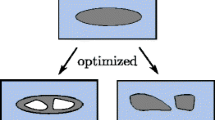Abstract
The Fluidic Self-Alignment Approach provides an alternative means for fast, economic, and precise handling of thousands of micro-scale parts. The present study aims to examine the important parameters which govern the mechanisms of the fluidic self-assembly process by numerical simulations. A simplified 2D model system consists of a solid plate, a micro-scale liquid slug and a micropart. The computational model is based on first principle conservation equations and is constructed by the coupling of two-phase modeling, solid structure modeling, and fluid–structure coupling. A matching experimental system is set up for the micropart of aspect ratio from 3:1 to 10:1 to validate the 2D computational simulations. Simulations reveal that a high degree of hydrophilicity between the lubricant and the solid surfaces is required for the self-assembly of microparts. A lower lubricant height, a higher surface tension coefficient and a higher viscosity enforce the re-alignment/restoration process also. Characterization of the flow field inside lubricant slug also indicates that the asymmetry of the vortices/stress distribution at both ends of the lubricant meniscus is resulted as the micropart in a back-and-forth restoration process.
Access this article
We’re sorry, something doesn't seem to be working properly.
Please try refreshing the page. If that doesn't work, please contact support so we can address the problem.






















Similar content being viewed by others
Abbreviations
- C :
-
damping coefficient
- F :
-
liquid volume fraction
- F SV :
-
volumetric surface tension force (N/m)
- g:
-
gravitational constant (m2/s)
- h :
-
lubricant height (m)
- K :
-
stiffness
- M :
-
mass (Kg)
- P :
-
pressure (Pa)
- t :
-
time (s)
- u :
-
nodal displacement vector
- U m :
-
velocity of the liquid–gas mixture (m/s)
- α:
-
contact angle
- αTop :
-
contact angle of micropart/lubricant/air
- αBottom :
-
contact angle of substrate/lubricant/air
- ρ m :
-
density of the liquid–gas mixture (kg/m3)
- μ m :
-
viscosity of the liquid–gas mixture (Pa s)
- γ:
-
surface tension (N/m)
- \( \overset{\lower0.5em\hbox{$\smash{\scriptscriptstyle\rightharpoonup}$}} {v} \) :
-
Velocity vector
References
Böhringer KF, Srinivsan U, Howe RT (2001) Modeling of capillary forces and binding sites for fluidic self-assembly. In: Proceedings of IEEE workshop on MEMS, Switzerland, 2001, pp 369–374
Brackbill JU, Kothe DB, Zemach C (1992) A continuum method for modelling surface tension. J Comput Phys 100:335–354
Chen YF, Tseng FG, Changchien SY, Chen MH, Yu RJ, Chieng CC (2007) Surface tension driven flow for open microchannels with different turning angles. Microfluid Nanofluid (in press). doi10.1007/s10404-007-0237-5
Fang J, Böhringer KF (2006) Parallel micro component-to-substrate assembly with controlled poses and high surface coverage. J Micromech Microeng 16:721–730
Grutzeck H (2005) Investigations of the capillary effect for gripping silicon chips. Microsyst Technol 11:194–203
Jacobs HO, Tao AR, Schwartz A, Gracias DH, Whitesides GM (2002) Fabrication of a cylindrical display by patterned assembly. Science 296:323–325
Kaneda M, Yamamoto M, Nakaso K, Yamamoto T, Fukai J (2007) Oscillation of a tilted circular pad on a droplet for the self-alignment process. Precis Eng 31:177–184
Kim JM, Yasuda K, Fujimoto K (2005) Resin self-alignment process for self-assembly systems. ASME J Electron Packag 127:18–24
Lienemann J, Greiner A, Korvink JG, Xiong X, Hanein Y, Böhringer KF (2003) Modelling, simulation and experimentation of a promising new packaging technology: parallel fluidic self-assembly of micro devices. Sensors Update 13(1):3–43
Lu Y, Xia S, Liu M, Zhang J (2006) Dynamic simulation of MEMS self-assembly using capillary force. In: Proceedings of the 1st IEEE international conference on nano/micro engineered and molecular systems, Zhuhai, China, 18–21 January 2006, pp 414–417
Martin BR, Furnange DC, Jackson TN, Mallouk TE, Mayer TS (2001) Self-alignment of patterned wafers using capillary forces at a water-air interface. Adv Funct Mater 11(5):381–386
Mittal R, Seshadri V, Sarma SE, Udaykumar HS (2002) Computation modeling of fluidic micro-handling processes. In: Fifth international conference on modeling and simulation of microsystem (MSM’02), San Juan, Puerto Rico, 2002
Sato K, Ito K, Hata S, Schimokohbe A (2003) Self-alignment of microparts using liquid surface tension-behavior of microparts and alignment characteristics. Precis Eng 27:42–50
Sato K, Lee K, Nishimura M, Okutsu K (2007) Self-alignment and bonding of microparts using adhesive droplets. Int J Precis Eng Manuf 8(2):75–79
Srinivsan U, Liepmann D, Howe RT (2001) Microstructure to substrate self-assembly using capillary forces. J Microelectromech Syst 10(1):17–24
Srinivsan U, Helmbrecht MH, Rembe C, Muller RS, Howe RT (2000) Fluidic self-assembly of micromirror onto surface micro-machined actuators. In: IEEE/LEOS Int Conf Optical MEMS, Kauai, HI, USA, pp 59–60
Stauth SA, Parviz BA (2006a) Modeling of fluidic self-assembly for integration of silicon components on plastic. In: 19th IEEE Int Conf Micro Electro Mechanical Systems, Istanbul, Turkey, 22–26 January 2006, pp 194–197
Stauth SA, Parviz BA (2006b) Self-assembled single-crystal silicon circuits on plastic. Proc Nat Acad Sci USA 103(38): 13922–13927
Tay AO, Li H, Gao X, Chen J, Kripesh V (2006) Numerical simulation of capillary and fluid dynamic forces on tiny chips in fluidic self-assembly process. In: Seventh international conference on thermal, mechanical and multiphysics simulation and experiments in micro-electronics and micro-systems, EuroSimE, 2006
Tsai CG, Hsieh CM, Yeh J (2007) Self-alignment of microchips using surface tension and solid edge. Sensor Actuators A Phys 139:343–349
Weber MW, Shandas R (2007) Computational fluid dynamics analysis of microbubble formation in microfluidic flow-focusing devices. Microfluid Nanofluid 3:195–206
Acknowledgements
The authors highly appreciate the supports from the National Science Council, Taiwan under contract NSC95-2323-B-007-004.
Author information
Authors and Affiliations
Corresponding author
Rights and permissions
About this article
Cite this article
Lin, C., Tseng, F., Kan, HC. et al. Numerical studies on micropart self-alignment using surface tension forces. Microfluid Nanofluid 6, 63–75 (2009). https://doi.org/10.1007/s10404-008-0294-4
Received:
Accepted:
Published:
Issue Date:
DOI: https://doi.org/10.1007/s10404-008-0294-4




